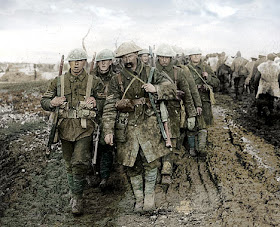On July 31, 1917, the Allies launch a renewed assault on German lines in the Flanders region of Belgium, in the much-contested region near Ypres, during World War I. The attack begins more than three months of brutal fighting, known as the Third Battle of Ypres or the Battle of Passchendaele.
While the first and second battles at Ypres were attacks by the Germans against the Allied-controlled salient around Ypres–which crucially blocked any German advance to the English Channel–the third was spearheaded by the British commander in chief, Sir Douglas Haig. After the resounding failure of the Nivelle Offensive–named for its mastermind, the French commander Robert Nivelle–the previous May, followed by widespread mutinies within the French army, Haig insisted that the British should press ahead with another major offensive that summer. The aggressive and meticulously planned offensive, ostensibly aimed at destroying German submarine bases located on the north coast of Belgium, was in fact driven by Haig’s (mistaken) belief that the German army was on the verge of collapse, and would be broken completely by a major Allied victory.
After an opening barrage of some 3,000 guns, Haig ordered nine British divisions, led by Sir Hubert Gough’s 5th Army, to advance on the German lines near the Belgian village of Passchendaele on July 31; they were joined by six French divisions. In the first two days of the attacks, while suffering heavy casualties, the Allies made significant advances–in some sectors pushing the Germans back more than a mile and taking more than 5,000 German prisoners–if not as significant as Haig had envisioned. The offensive was renewed in mid-August, though heavy rains and thickening mud severely hampered the effectiveness of Allied infantry and artillery and prevented substantial gains over the majority of the summer and early fall.
Dissatisfied with his army’s gains by the end of August, Haig had replaced Gough with Herbert Plumer at the head of the attack; after several small gains in September, the British were able to establish control over the ridge of land east of Ypres. Encouraged, Haig pushed Plumer to continue the attacks towards the Passchendaele ridge, some 10 kilometers from Ypres.
Thus the Third Battle of Ypres–also known as Passchendaele, for the village, and the ridge surrounding it, that saw the heaviest fighting–continued into its third month, as the Allied attackers reached near-exhaustion, with few notable gains, and the Germans reinforced their positions in the region with reserve troops released from the Eastern Front, where Russia’s army was foundering amid internal turmoil. Unwilling to give up, Haig ordered a final three attacks on Passchendaele in late October. The eventual capture of the village, by Canadian and British troops, on November 6, 1917, allowed Haig to finally call off the offensive, claiming victory, despite some 310,000 British casualties, as opposed to 260,000 on the German side, and a failure to create any substantial breakthrough, or change of momentum, on the Western Front. Given its outcome, the Third Battle of Ypres remains one of the most costly and controversial offensives of World War I, representing–at least for the British–the epitome of the wasteful and futile nature of trench warfare.
Article Details:
July 31, 1917 : Third Battle of Ypres begins in Flanders
Author
History.com StaffWebsite Name
History.comYear Published
2009Title
July 31, 1917 : Third Battle of Ypres begins in FlandersURL
http://www.history.com/this-day-in-history/third-battle-of-ypres-begins-in-flandersAccess Date
July 31, 2015Publisher
A+E Networks






















































